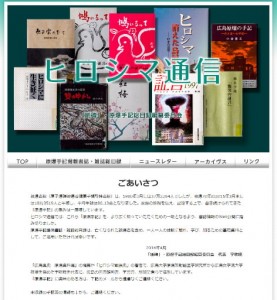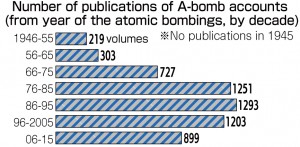New website on A-bomb accounts is launched from Hiroshima
Apr. 24, 2016
by Masami Nishimoto, Senior Staff Writer
As many as 5,895 volumes of A-bomb accounts were found to have been published in the seven decades since the atomic bombings of Hiroshima and Nagasaki in 1945. Researchers that include Satoru Ubuki, 69, a former professor at Hiroshima Jogakuin University, have explored a variety of publications, such as privately-held books and newsletters of organizations, along with books and magazines that even public libraries have not collected. The researchers have launched a website called “Hiroshima Tsushin” (“Hiroshima Letters”) where visitors can search these materials. They will continue to analyze the A-bomb accounts, which exceed a total of 50,000, with a focus on studying the consequences of the atomic bombings.
Mr. Ubuki heads a committee composed of librarians and other participants who are seeking to compile a general catalog of books and magazines that carry A-bomb survivors’ accounts. The committee members have been reviewing the books and magazines collected by the Peace Memorial Museum Information Room, established in 1973, and by the Hiroshima National Peace Memorial Hall for the Atomic Bomb Victims, established in 2002, as well as newly found materials published in the period of occupation (1945-1952) and magazines containing A-bomb accounts from the years of the movement against A- and H-bombs and antinuclear campaigns.
The publication of A-bomb accounts began in 1946, one year after the atomic bombings, and has continued to this day. The accounts describe the horrific conditions of the A-bomb attacks; feelings about lost family members, relatives, and friends; suffering and discrimination; the desire for peace; and other sentiments.
The database created by the committee members includes a magazine titled Shiranui Tsuitougo (Sea of Fire Remembrance Edition), which was published in February 1946 by students at the Seventh High School (now Kagoshima University) who had been exposed to the atomic bombing of Nagasaki, and a magazine titled Izumi: Mitama no Mae ni Sasaguru (Fountain Offered Before the Spirits), published in August 1946 by the third-year students at Hiroshima First Middle School (now Kokutaiji High School). The committee members sorted all the materials they found, by year, to create the database which incorporates the names of books, editors, and publishers as well as the locations in Hiroshima that have collected the books and magazines.
Looking at the publications by year, in 1975, 30 years after the atomic bombings and the time when people began to believe the A-bomb memories were fading, the number of publications amounted to 107 volumes. This number then rose to 232 volumes in 1985 when the antinuclear movement that was launched in Europe spread internationally. In 1995, half a century after the end of the war, a record 300 volumes were produced. But after entering the year 2000, the number began to decline. In 2015, when the average age of the A-bomb survivors reached 80.13, a total of 78 volumes, including Izumi Daisanshu (Fountain, The Third Collection), were compiled and published.
The website project is being pursued with the aim of making use of A-bomb accounts, which are significant records but not well known among the public. The site also offers academic research reports and information on books and magazines linked to the atomic bombings that were published soon after the attacks.
Journalists and researchers residing in Hiroshima called for creating the catalog of A-bomb experiences. In 1972, the Genbaku Hisaishiryou Somokuroku Daisanshu (The General Catalog of Materials on the A-bomb Damage, 3rd Edition) was published, which collected information on 314 books and magazines. Mr. Ubuki edited the Genbaku Shuki Keisaishoshi Ichiran (General Catalog of Books and Magazines Carrying A-bomb Accounts) in 1996 while working as an assistant professor at the Hiroshima University Research Institute for Radiation Biology and Medicine. That catalog included 3,542 volumes with 37,793 A-bomb accounts.
First step for the actual A-bomb conditions
Comment by Satoru Ubuki: A-bomb accounts are significant records that specifically convey the actual conditions of the atomic bombings. These accounts have continued to be written, prompted by incidents and movements in and out of Japan involving nuclear issues. By exploring the content of the A-bomb accounts, new aspects can be discovered. I hope people will make use of the website as their first step in obtaining materials to learn about the atomic bombings.
(Originally published on April 24, 2016)
As many as 5,895 volumes of A-bomb accounts were found to have been published in the seven decades since the atomic bombings of Hiroshima and Nagasaki in 1945. Researchers that include Satoru Ubuki, 69, a former professor at Hiroshima Jogakuin University, have explored a variety of publications, such as privately-held books and newsletters of organizations, along with books and magazines that even public libraries have not collected. The researchers have launched a website called “Hiroshima Tsushin” (“Hiroshima Letters”) where visitors can search these materials. They will continue to analyze the A-bomb accounts, which exceed a total of 50,000, with a focus on studying the consequences of the atomic bombings.
Mr. Ubuki heads a committee composed of librarians and other participants who are seeking to compile a general catalog of books and magazines that carry A-bomb survivors’ accounts. The committee members have been reviewing the books and magazines collected by the Peace Memorial Museum Information Room, established in 1973, and by the Hiroshima National Peace Memorial Hall for the Atomic Bomb Victims, established in 2002, as well as newly found materials published in the period of occupation (1945-1952) and magazines containing A-bomb accounts from the years of the movement against A- and H-bombs and antinuclear campaigns.
The publication of A-bomb accounts began in 1946, one year after the atomic bombings, and has continued to this day. The accounts describe the horrific conditions of the A-bomb attacks; feelings about lost family members, relatives, and friends; suffering and discrimination; the desire for peace; and other sentiments.
The database created by the committee members includes a magazine titled Shiranui Tsuitougo (Sea of Fire Remembrance Edition), which was published in February 1946 by students at the Seventh High School (now Kagoshima University) who had been exposed to the atomic bombing of Nagasaki, and a magazine titled Izumi: Mitama no Mae ni Sasaguru (Fountain Offered Before the Spirits), published in August 1946 by the third-year students at Hiroshima First Middle School (now Kokutaiji High School). The committee members sorted all the materials they found, by year, to create the database which incorporates the names of books, editors, and publishers as well as the locations in Hiroshima that have collected the books and magazines.
Looking at the publications by year, in 1975, 30 years after the atomic bombings and the time when people began to believe the A-bomb memories were fading, the number of publications amounted to 107 volumes. This number then rose to 232 volumes in 1985 when the antinuclear movement that was launched in Europe spread internationally. In 1995, half a century after the end of the war, a record 300 volumes were produced. But after entering the year 2000, the number began to decline. In 2015, when the average age of the A-bomb survivors reached 80.13, a total of 78 volumes, including Izumi Daisanshu (Fountain, The Third Collection), were compiled and published.
The website project is being pursued with the aim of making use of A-bomb accounts, which are significant records but not well known among the public. The site also offers academic research reports and information on books and magazines linked to the atomic bombings that were published soon after the attacks.
Journalists and researchers residing in Hiroshima called for creating the catalog of A-bomb experiences. In 1972, the Genbaku Hisaishiryou Somokuroku Daisanshu (The General Catalog of Materials on the A-bomb Damage, 3rd Edition) was published, which collected information on 314 books and magazines. Mr. Ubuki edited the Genbaku Shuki Keisaishoshi Ichiran (General Catalog of Books and Magazines Carrying A-bomb Accounts) in 1996 while working as an assistant professor at the Hiroshima University Research Institute for Radiation Biology and Medicine. That catalog included 3,542 volumes with 37,793 A-bomb accounts.
First step for the actual A-bomb conditions
Comment by Satoru Ubuki: A-bomb accounts are significant records that specifically convey the actual conditions of the atomic bombings. These accounts have continued to be written, prompted by incidents and movements in and out of Japan involving nuclear issues. By exploring the content of the A-bomb accounts, new aspects can be discovered. I hope people will make use of the website as their first step in obtaining materials to learn about the atomic bombings.
(Originally published on April 24, 2016)









